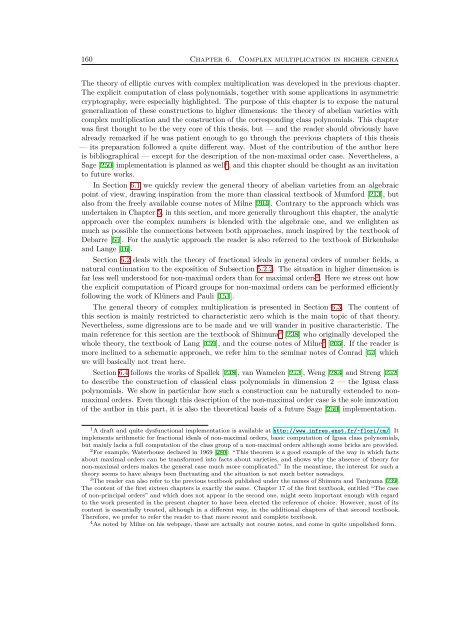here - Sites personnels de TELECOM ParisTech - Télécom ParisTech
here - Sites personnels de TELECOM ParisTech - Télécom ParisTech
here - Sites personnels de TELECOM ParisTech - Télécom ParisTech
You also want an ePaper? Increase the reach of your titles
YUMPU automatically turns print PDFs into web optimized ePapers that Google loves.
160 Chapter 6. Complex multiplication in higher generaThe theory of elliptic curves with complex multiplication was <strong>de</strong>veloped in the previous chapter.The explicit computation of class polynomials, together with some applications in asymmetriccryptography, were especially highlighted. The purpose of this chapter is to expose the naturalgeneralization of these constructions to higher dimensions: the theory of abelian varieties withcomplex multiplication and the construction of the corresponding class polynomials. This chapterwas first thought to be the very core of this thesis, but — and the rea<strong>de</strong>r should obviously havealready remarked if he was patient enough to go through the previous chapters of this thesis— its preparation followed a quite different way. Most of the contribution of the author <strong>here</strong>is bibliographical — except for the <strong>de</strong>scription of the non-maximal or<strong>de</strong>r case. Nevertheless, aSage [250] implementation is planned as well 1 , and this chapter should be thought as an invitationto future works.In Section 6.1 we quickly review the general theory of abelian varieties from an algebraicpoint of view, drawing inspiration from the more than classical textbook of Mumford [213], butalso from the freely available course notes of Milne [204]. Contrary to the approach which wasun<strong>de</strong>rtaken in Chapter 5, in this section, and more generally throughout this chapter, the analyticapproach over the complex numbers is blen<strong>de</strong>d with the algebraic one, and we enlighten asmuch as possible the connections between both approaches, much inspired by the textbook ofDebarre [65]. For the analytic approach the rea<strong>de</strong>r is also referred to the textbook of Birkenhakeand Lange [16].Section 6.2 <strong>de</strong>als with the theory of fractional i<strong>de</strong>als in general or<strong>de</strong>rs of number fields, anatural continuation to the exposition of Subsection 5.2.2. The situation in higher dimension isfar less well un<strong>de</strong>rstood for non-maximal or<strong>de</strong>rs than for maximal or<strong>de</strong>rs 2 . Here we stress out howthe explicit computation of Picard groups for non-maximal or<strong>de</strong>rs can be performed efficientlyfollowing the work of Klüners and Pauli [151].The general theory of complex multiplication is presented in Section 6.3. The content ofthis section is mainly restricted to characteristic zero which is the main topic of that theory.Nevertheless, some digressions are to be ma<strong>de</strong> and we will wan<strong>de</strong>r in positive characteristic. Themain reference for this section are the textbook of Shimura 3 [238] who originally <strong>de</strong>veloped thewhole theory, the textbook of Lang [159], and the course notes of Milne 4 [205]. If the rea<strong>de</strong>r ismore inclined to a schematic approach, we refer him to the seminar notes of Conrad [57] whichwe will basically not treat <strong>here</strong>.Section 6.4 follows the works of Spallek [248], van Wamelen [273], Weng [283] and Streng [252]to <strong>de</strong>scribe the construction of classical class polynomials in dimension 2 — the Igusa classpolynomials. We show in particular how such a construction can be naturally exten<strong>de</strong>d to nonmaximalor<strong>de</strong>rs. Even though this <strong>de</strong>scription of the non-maximal or<strong>de</strong>r case is the sole innovationof the author in this part, it is also the theoretical basis of a future Sage [250] implementation.1 A draft and quite dysfunctional implementation is available at http://www.infres.enst.fr/~flori/cm/. Itimplements arithmetic for fractional i<strong>de</strong>als of non-maximal or<strong>de</strong>rs, basic computation of Igusa class polynomials,but mainly lacks a full computation of the class group of a non-maximal or<strong>de</strong>rs although some bricks are provi<strong>de</strong>d.2 For example, Waterhouse <strong>de</strong>clared in 1969 [280]: “This theorem is a good example of the way in which factsabout maximal or<strong>de</strong>rs can be transformed into facts about varieties, and shows why the absence of theory fornon-maximal or<strong>de</strong>rs makes the general case much more complicated.” In the meantime, the interest for such atheory seems to have always been fluctuating and the situation is not much better nowadays.3 The rea<strong>de</strong>r can also refer to the previous textbook published un<strong>de</strong>r the names of Shimura and Taniyama [239].The content of the first sixteen chapters is exactly the same. Chapter 17 of the first textbook, entitled “The caseof non-principal or<strong>de</strong>rs” and which does not appear in the second one, might seem important enough with regardto the work presented in the present chapter to have been elected the reference of choice. However, most of itscontent is essentially treated, although in a different way, in the additional chapters of that second textbook.T<strong>here</strong>fore, we prefer to refer the rea<strong>de</strong>r to that more recent and complete textbook.4 As noted by Milne on his webpage, these are actually not course notes, and come in quite unpolished form.
















